According to medical statistics, from 20 to 30% of the population of our planet have suffered from urticaria at least once in their lives. And those who have never suffered this illness themselves, to one degree or another, have at least a general idea of it. The idea that this is a childhood disease is absolutely wrong. Urticaria (Urticaria), a skin disease (mainly of an allergic nature), can occur in people of all ages. In our review article we will try to tell you what causes urticaria in adults, how to treat it, and also talk about publicly available preventive measures that will help prevent this disease.
External signs of the disease
What does urticaria look like in adults? The main external signs of the disease are the appearance on the body of numerous severely itchy redness, induration, inflammation, spots and blisters (fairly flat) of red or pink color. In appearance, the swelling is largely reminiscent of nettle burns (hence the common name). The development of the disease can occur very quickly: neoplasms on the body can appear within just a few minutes. The size of the swelling varies from a few millimeters to tens of centimeters. Over time, several small blisters may merge into one. External symptoms of urticaria appear on the legs, arms, back, abdomen and other parts of the body. It is especially dangerous for human health when swelling affects the respiratory tract (the person begins to choke) and the genitals (which leads to the inability to urinate).
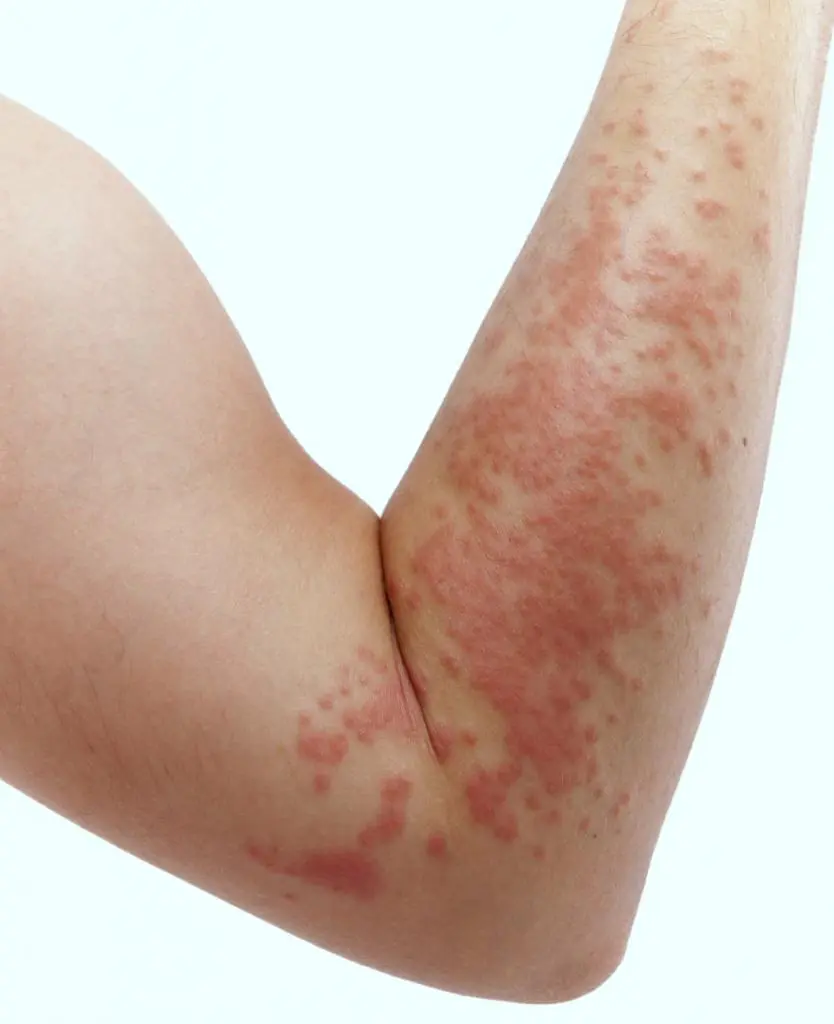
Minor signs
Associated symptoms of urticaria in adults include the sudden onset of muscle weakness, headache, nausea, chills, runny nose, diarrhea, fever, fever and cough. These secondary signs sometimes make it difficult to make a correct diagnosis, especially if the inflammation of the skin is not too obvious. It is easy to confuse the disease with, for example, ordinary food poisoning.
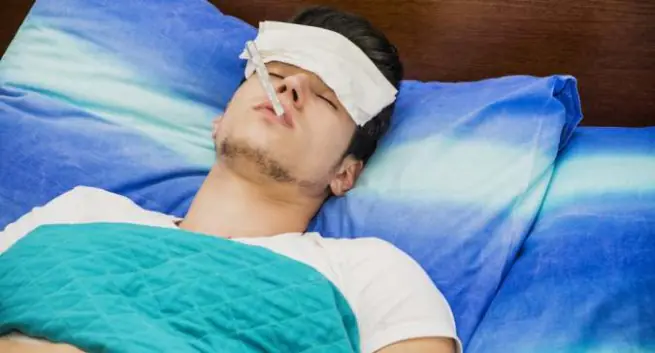
The mechanism of occurrence and development of urticaria
What causes urticaria in adults? The composition of human skin (and other connective tissues) includes mast cells that have capsules inside filled with histamine. When an allergic reaction occurs in the human body, this substance is released, enters the subcutaneous space through capillary vessels, accumulates and causes swelling and rash. That is, the mechanism of the disease is the rapid release of histamine from mast cells.
If the swelling can be stopped within 36 hours, then no damaged areas remain on the skin. Otherwise, damage to the walls of blood vessels begins.
Important! If, during the course of the disease, swelling spreads to the respiratory system, this can lead to the most severe consequences. In this case, emergency medical care is required!
Varieties
There are two main types of urticaria:
- Spicy. The duration of the disease usually does not exceed 5-6 weeks. As a rule, with proper and timely treatment, external manifestations can be eliminated within 24-36 hours.
- Chronic. Symptoms may last for several months (in particularly severe cases, even several years). According to experts, about 0.1% of humanity currently suffers from this disease.
Please note: one of the most dangerous types of acute urticaria is angioedema. It is accompanied by the rapid formation of compactions in the area of the eyes, lips and cheeks. The main danger is possible swelling of the larynx, which can lead to asphyxia (with all the ensuing consequences). To prevent death, urgent drug treatment is required.
Causes of allergic urticaria
The main cause of urticaria in adults is the body's reaction to a specific allergen. Moreover, a person may not even know what substance was the “provocateur” of the disease. The main triggers that cause a true allergic reaction in the body are food, medications, chemical compounds (including household detergents), pet hair, insect bites (bees, wasps, ticks, flies or cockroaches), pollen and, oddly enough, even ordinary household dust. In some cases (even with comprehensive examinations and numerous laboratory tests), the true cause of the disease cannot be determined.
One of the reasons for the appearance of urticaria in adults, no matter how paradoxical it may sound, is age. With its increase (especially after 40 years), the allergic reactions of the human body intensify. And, as a result, Urticaria can become a reaction to any everyday food product or habitual medicine.
On a note! If you find obvious signs of urticaria in an adult after sleep, then most likely the cause could be bites of the so-called bed tick. In addition to treating the disease itself, it is necessary to properly treat all bedding (mattress, pillows, blanket, etc.).
Non-allergic causes of the disease
In addition to allergies, the causes of urticaria in adults can be:
- various (especially chronic) diseases of the liver, kidneys, gastrointestinal tract, endocrine system, thyroid gland;
- pathogenic bacteria and viruses;
- inflammatory processes;
- stressful situations;
- intestinal parasites;
- the body's reaction to a sharp drop in ambient temperature or solar activity.
Diagnostics
An experienced specialist, when examining a patient and visually examining the skin rash, can find out what causes urticaria in adults. To make a correct diagnosis, a doctor (dermatologist, allergist or immunologist), first of all, will need detailed answers from the patient to the questions posed to him:
- When did external signs begin to appear?
- Was there an insect bite before this and, if so, what kind?
- What medications (and in what dosages) was the person taking before the incident?
- What did the patient eat during the day?
- What chronic diseases does the patient suffer from?
- Was there any contact with animals or chemicals?
As a rule, detailed answers to the above questions will be enough for an experienced specialist to make the correct diagnosis and prescribe effective treatment. The main thing is to find out the reason that caused the hives, because the next encounter with this allergen can lead to more serious consequences.
For chronic urticaria, laboratory tests are prescribed:
- general and biochemical blood test;
- test to identify problems with the immune system;
- skin tests;
- determination of the content of immunoglobulin E (its increased concentration indicates a predisposition to allergic reactions of the body, including urticaria);
- stool analysis to identify the presence of parasites in the body;
- checking the functioning of the kidneys, liver, thyroid gland and gastrointestinal tract.
Since sometimes even numerous laboratory tests do not allow us to identify the true cause of urticaria, in case of a chronic recurrent disease, a journal with records of all the events preceding the incident will help to identify the trigger. Subsequent analysis of systematized data greatly simplifies the search for a “provocateur.”
Drug treatment of acute urticaria
Various antihistamines have been successfully used to treat acute urticaria. Most of these medications are available without a prescription. And although experts do not recommend self-medication with medications, success in the fight against the disease largely depends on efficiency (often running to the pharmacy for medicine will take much less time than waiting for the local doctor to arrive).
The list of the most popular and very effective drugs taken for urticaria in adults: Diazolin, Cetrin (Cetirizine), Zyrtec, Fexofenadine, Erius. These medications help block the negative effects of histamine, reduce external rashes, and stop painful itching. In most cases, after the surgical use of these medications, a positive effect is observed. But further actions related to how and how to treat urticaria in adults should be done only after consultation with a specialist. It is he who will determine the duration of the course of treatment and give all the necessary recommendations.
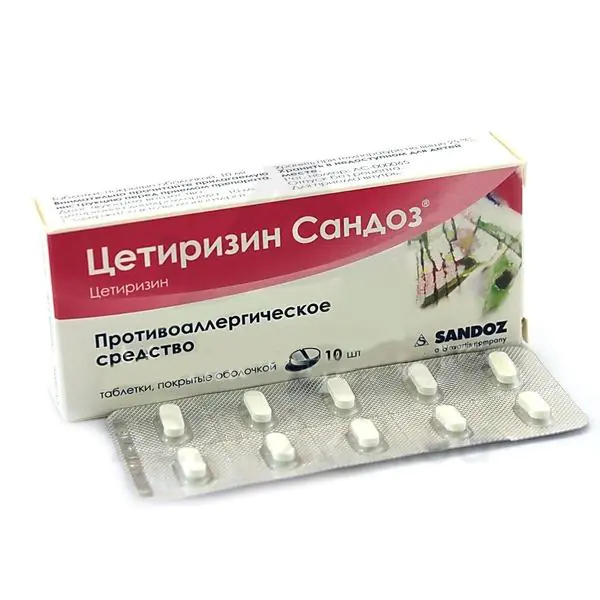
Treatment of chronic urticaria
When treating chronic urticaria, antihistamines (even in fairly large doses) cannot quickly reduce swelling and itching. How to treat urticaria in adults in this case? Specialists use special hormonal drugs – glucocorticosteroids – to treat chronic urticaria. The most well-known and frequently used medications of this group, produced in the form of tablets or injections: Prednisolone, Dexamethasone, Prednisone, Triamcinolone, Betamethasone.
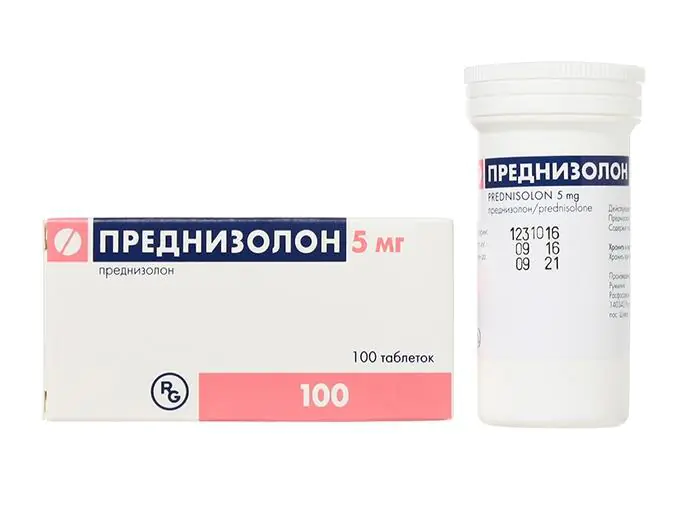
Using hormones on a regular basis is difficult because of the risk of serious side effects such as osteoporosis, glaucoma, diabetes, and a weakened immune system in general. Therefore, so-called monoclonal antibodies have recently been successfully used to treat severe cases of frequently recurring urticaria. The injectable drug "Omalizumab" ("Omalizumab" or "Xolair") blocks molecules of the immunoglobulin E protein, which plays a major role in the body's allergic reactions. A positive effect is observed even in the treatment of urticaria of unknown origin. A course of use of this drug leads not only to the elimination of symptoms, but also removes the causes of the chronic disease until it is completely cured.
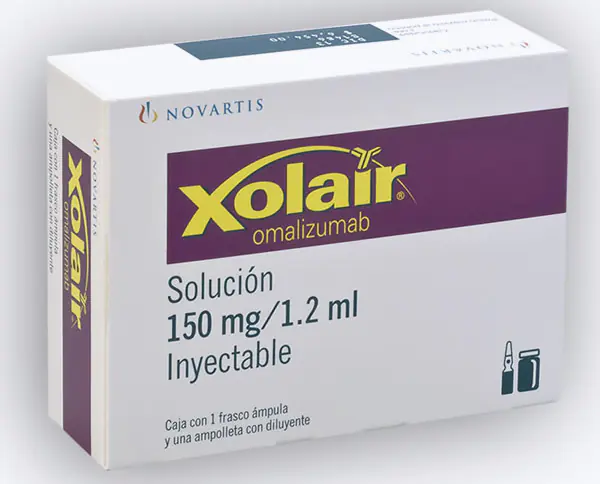
First aid for urticaria in adults
Before being examined by a doctor and prescribing treatment methods, the patient can provide first aid to himself at home:
- First of all, we ventilate the room;
- we take any antiallergic drug (if it is available in the home medicine cabinet);
- take off clothes or put on looser clothes (made of soft materials that do not injure the skin);
- take a cool shower or bath;
- apply cold compresses to the most itchy areas;
- We go to bed (under no circumstances should you tolerate hives on your legs).
When is emergency medical care required?
Severe cases of allergic urticaria require immediate medical attention. The main signs for calling emergency help are:
- swelling of the lining of the mouth, tongue, lips, and throat;
- labored breathing;
- high body temperature (39°C or more);
- loss of consciousness or inadequacy in expressing thoughts;
- cardiopalmus;
- severe nausea and vomiting;
- cold and clammy skin.
If a patient with the symptoms described above is not provided with emergency medical care, this can lead to very serious consequences, even fatal.
Diet
Strict adherence to a certain diet plays an important role in the treatment of urticaria. First of all, foods that have the greatest effect on the production of histamine in the body’s mast cells should be excluded from the diet. These include spinach, chocolate, strawberries, fatty meats, tomatoes, yoghurts, fish and other seafood (shrimp, crabs, etc.). Also, during the treatment period, you should not drink alcoholic beverages, honey (and other sweets), eggs, coffee and strong tea.

What you can eat if you have hives: porridge (oatmeal or rice), boiled potatoes, fresh vegetables (cabbage, zucchini or cucumbers), boiled lean meat (turkey, chicken breast or beef), pears and apples.
Folk remedies in the fight against urticaria
The treatment of urticaria with folk remedies in adults must be approached with extreme caution. Any ingredient (or maybe several at once) may be a trigger for an allergic reaction, which the patient may not even be aware of, since he has not encountered it in everyday life. Before putting into practice the recipes of traditional healers, it is better to first consult with a specialist.
How to relieve itching with urticaria in an adult:
- Pour boiling water over a mixture of equal parts of string, chamomile and oak bark. Let it brew for 1-1.5 hours. Strain the broth and gently moisten the blisters with it.
- A paste of grated raw potatoes applied to inflamed areas helps to significantly reduce itching and swelling.
- A bath with the addition of an infusion of valerian leaves, celandine, St. John's wort and string to the water helps reduce pain symptoms.
Two simple and affordable recipes for treating urticaria in adults with folk remedies:
- Pour boiling water over mint leaves and leave for 30-40 minutes. Take orally three times a day before meals.
- Tea from walnut leaves, prepared at the rate of 2 teaspoons per 0.5 liter of water. A special feature of the preparation is the brewing time - at least 10 minutes.
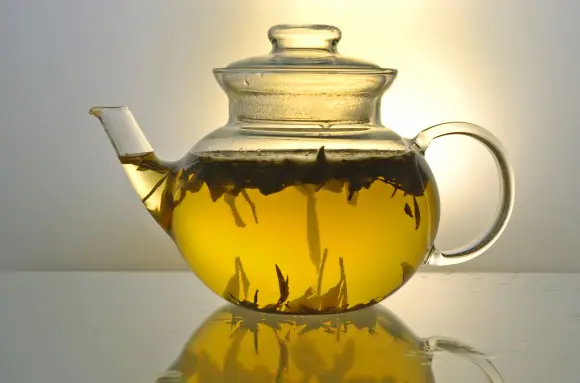
Preventive measures
We briefly addressed the question of what causes urticaria in adults and how to treat it. However, taking fairly simple preventive measures will help significantly reduce the risk of this disease:
First of all, it is necessary to completely eliminate contact with specific allergens known to a person from personal experience or identified during clinical studies.
Getting rid of bad habits (for example, drinking alcohol and smoking) will not only have a positive effect on overall physical health, but will also strengthen the body's anti-allergic capabilities. Timely treatment of pathologies of the gastrointestinal tract, liver and kidneys will help reduce the likelihood of urticaria.
Both overheating and hypothermia of the body should be avoided. Therefore, sunbathing and walking in the cold need to be dosed wisely. Emotional stress not only weakens the nervous system, but can also be a trigger for the occurrence of hives. Therefore, naturally, if possible, they should be avoided or at least minimized.
Last (but not least) what you should pay attention to is your daily diet. Excluding highly allergenic foods from it significantly reduces the likelihood of developing the disease.
Small pink blisters on the body and limbs that itch incessantly cause a lot of discomfort for adults and children, especially if they appear with high frequency and the nature of their occurrence is unknown. Often this is a symptom of urticaria - a very unpleasant illness that can even endanger life if proper treatment is not carried out in a timely manner. Why does it occur and how to deal with it?
What is urticaria
This common skin condition has several alternative names: nettle fever, urticaria, or urticarial rash. Urticaria is a type of dermatitis, mainly of allergic origin. Sometimes this is only a symptom and not an independent disease, since urticaria in adults and children can accompany:
- bronchial asthma;
- allergic shock;
- autoimmune diseases.
The name of the disease is telling, since the rash in the form of small pink blisters visually resembles a nettle burn. According to official statistics, every third inhabitant of the globe encountered this problem, and for 15% of people it appeared twice. Mostly urticaria is diagnosed in people aged 20-40 years, women suffer from it more often than men, so the role of hormonal levels in its development cannot be ruled out. Another name for the disease - polyetiological dermatosis - well reflects the wide range of factors that can provoke its occurrence.
What does an allergic rash look like?
The main symptom of urticaria is flat, pink blisters, which can be small in size or form large plaques. In appearance (especially in photographs of patients), they are almost identical to the blisters that occur with a nettle burn, but the affected area is larger, and the rash is characterized by migration and sudden disappearance. The surrounding skin is dark red in color; when pressed, the bubbles become lighter. The appearance of an allergic rash is accompanied by severe itching.
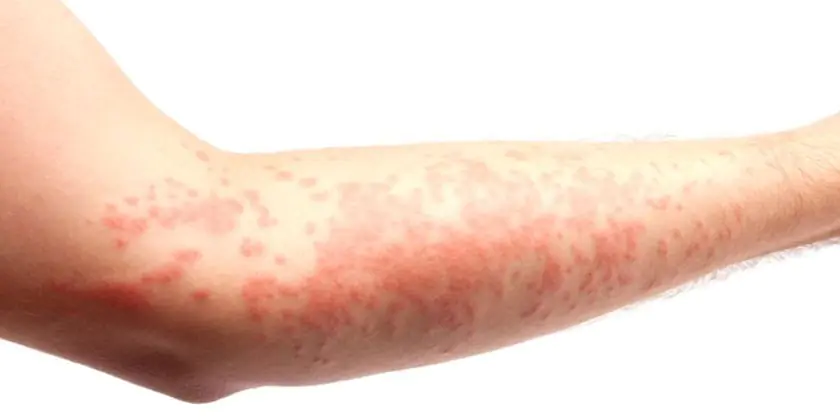
Stages of pathology
Doctors call the leading mechanism for the development of urticaria the formation of reagins (special antibodies) in response to an allergen entering the body, which creates a state of sensitization: increased sensitivity to an irritant. When it re-enters, it combines with reagins, which leads to the release of mast cells, their degranulation (the process of destruction of granules) and the release of histamine. A classic allergic reaction of immediate type has the following stages of development:
- Immunological – the stage of sensitization, observed at the moment of direct contact with the allergen, characterized by the initiation of a response. The more the irritant is carried through the bloodstream, the more actively sensitized leukocytes (antibodies) are synthesized and accumulated. There are no clinical manifestations at this stage, but it is possible to notice changes in the activity of some enzymes and the concentration of immunoglobulins.
- Pathochemical – cellular and serum proteolytic and lipolytic enzymes are activated, allergy mediators are released: histamine, heparin, prostaglandins. They are then activated, interacting with the stimulus, which leads to changes in the tissues and fluids of the body.
- Pathophysiological - due to the activity of allergy mediators, vascular permeability increases, and a damaging effect on cellular tissue elements is observed. At this stage, local and general symptoms of urticaria appear, including irritation of nerve receptors (itching, burning), the development of edema, blisters, spasms of the bronchioles and intestines.
Causes of urticaria in adults
According to the etiology (nature of origin), the disease can be pseudo-allergic in nature (infections, chronic diseases, parasitic infestations) or allergic - occurs from direct contact with an irritant. If the exact factor that triggered its development remains unclear, it is reflected in the diagnosis as idiopathic urticaria. Common causes of urticaria rash:
- Infectious diseases (15% of cases) – bacterial and viral etiology (origin), especially chronic ones. The role of caries, adnexitis (inflammation of the appendages), tonsillitis (inflammation of the tonsils), and herpes is especially important.
- Diseases of the liver, stomach, intestines - gastritis, hepatitis, cholecystitis, and ulcers are especially closely associated with urticaria.
- Disorders in the immune system (20% of cases) are characterized by the development of autoimmune reactions, in which the body perceives its own cells as “strangers” and attacks them. This form can be severe, and the use of antihistamines does not produce results.
- Food (food allergies, up to 10% of cases) – plays a less significant role in adults than in children. It may be based on enzyme deficiency or chronic inflammatory processes.
- Neuroendocrine disorders (mainly in women) - hormonal problems, diabetes, stressful situations, thyroiditis (lack of thyroid hormones).
- Factors of natural origin - sun, cold, heat.
- Leukemia (and other blood diseases) - leads to increased bleeding of blood vessels, provokes an urticarial rash with a tendency to allergies.



Provoking factors (triggers)
A large number of physical factors can act as irritants, each of which causes a different type of urticaria. They differ not only in the stimulus, but also in the nature of the flow. The general classification mentions the following varieties:
- Cold – the body reacts to cold air or water, and in some people, to food at low temperatures (ice cream, some desserts). In the reflex form, the reaction occurs when touching the allergen. Blisters form around areas that come into contact with it.
- Solar - a reaction to ultraviolet radiation occurs on uncovered areas of the skin and develops within a few minutes after contact with the allergen. Allergies occur mainly in summer, during times of increased solar activity.
- Thermal – is formed in people who react acutely to staying in a sauna, steam bath, bath, or to an increase in body temperature during physical activity. As a result of overheating, a large rash appears in the form of plaques fused together.
- Contact - an allergic reaction develops as a result of interaction with household chemicals and cosmetics (decorative and caring). The rash is mild and disappears almost immediately after contact with the irritant is eliminated.
- Allergic – observed upon contact with plant pollen, animal hair, dust. Symptoms disappear immediately after the irritant is eliminated; the severity of the condition is always individual: anaphylactic shock is possible.
- Medicinal – occurs when there is intolerance to gamma globulins, antibiotics and other medicinal substances; skin symptoms do not always appear immediately (up to 2 weeks), which makes it difficult to determine the cause of the allergic reaction.
- Dermographic - appears as a result of mechanical irritation: from tight clothing (or unpleasant fabric), a tightly tightened belt, sharp fittings. First, severe itching appears, followed by a rash in the form of thin small stripes. Characteristic for people with sensitive skin. Symptoms persist for several days, but there is no deterioration in general health.
- Aquagenic - the rash with such urticaria may be completely absent or invisible, but the itching will always be there. The reaction occurs when a substance produced by the skin reacts chemically with water.
- Idiopathic - this diagnosis is made when the exact allergen has not been identified, so the clinical picture is always different.
Symptoms and features of the course
Urticaria in adults begins with the sudden appearance of pink blisters on the skin and mucous membranes, most of them will appear within an hour: during this period the maximum concentration of histamine is observed. Afterwards, small blisters may appear, and after a few hours a second wave of urticaria occurs, but the rash may also disappear. External signs are often accompanied by a general deterioration in well-being:
- headache;
- temperature;
- weakness, weakness;
- decreased performance.
Acute
An abrupt onset, with the appearance of a large number of blisters on the skin within an hour after contact with the irritant, is the main symptom of the acute form. Its duration ranges from a day to 2 weeks. In addition to local manifestations, there are also signs of general malaise, including:
- nervous system disorders;
- headache;
- fever (up to 38 degrees), lethargy.
Often, if the rash does not disappear from the dermis within a few hours, local swelling of the subcutaneous tissue, muscles, fascia, and mucous membranes may develop, which leads to Quincke's edema. It mainly occurs on the face and is characterized by a rapid appearance (within 2-5 minutes) and painful itching. The exact symptoms depend on the area affected. If the larynx is affected, the person experiences asphyxia (suffocation) and faces speech impairment. A patient with such symptoms should be immediately hospitalized.
Urticaria in adults is common. This problem has occurred at least once in 20% of the world's population. Despite the fact that the causes of the pathology may vary, the symptoms and treatment methods are largely the same. Next - about the different manifestations of urticaria in adults, photos of symptoms and treatment.
Photo of Urticaria in adults 8 pieces with description
Causes and triggers of urticaria in adults
The causes of hives in adults vary. Identifying provoking factors is not an easy task even for experienced specialists.
In the vast majority of circumstances, the disease is formed on the basis of one of the pathologies. Among them:
- endocrine disorders;
- problems with the gastrointestinal tract (especially gastritis and ulcers of various types);
- Liver diseases and gallbladder pathologies;
- dysbacteriosis;
- lupus erythematosus (and other systemic diseases);
- cancerous tumors;
- parasite damage (a common cause of urticaria in adults);
- allergic response of the body to an intolerable component;
- advanced infectious diseases (or bacterial);
- prolonged stress;
- hypersensitivity to high and low temperatures, as well as to sunlight.
In addition, with urticaria in adults, the cause of the pathology can be blood transfusions.
All of the above provokes weakening and improper functioning of the immune system. As a result, the body cannot cope with the load and reacts to this with rashes and swelling.
What causes urticaria in adults is not completely known even now. However, in a number of situations, the cause is precisely the functioning of the immune system.
Symptoms of urticaria in adults
Symptoms of urticaria in adults vary depending on the type of pathology. However, they are usually similar.
The general symptoms are as follows:
- intense itching (appears first);
- swelling of the skin (you can look at the photo of urticaria in adults);
- the formation of pink and reddish blisters on the skin (flat and with unclear outlines, can be different in size and localized in different areas of the body);
- weakness and malaise;
- temperature increase;
- chills;
- nausea and problems with stool;
- hyperemia.
What urticaria looks like in adults depends on the degree, nature and location of the disease:
- Urticarial vasculitis. There is inflammation of the capillary and vascular walls, which appears in the form of specific blisters. Symptoms persist for up to 5-6 days. It often appears on the face (photos of urticaria on the face of adults are available online).
- Papular form. Tissue swelling is observed. On the skin there is hyperpigmentation in the fold areas. The outer epidermal layer thickens and becomes rough. Photos of urticaria in adults on the body can be viewed online.
- Cholinergic urticaria. Appears due to the active release of a neurotransmitter. Pinkish blisters form on the skin of the entire body. May appear after stress and intense physical activity. Other symptoms include shortness of breath, heavy breathing and general weakness.
- Aquagenic type. An allergic response of the body to minerals in water. Blisters form on the epidermis. Often on your feet. Photos of urticaria on the legs of adults clearly demonstrate the situation. It passes quickly and does not have serious consequences.
- Adrenergic urticaria. A rare event. The reason is stress. A specific type of papules form on the skin surface.
- Contact type. The reason is contact with an allergen. Pinkish blisters appear on the skin, uniting into groups over time.
- Demographic. The reason is external effects on the skin. Appears as reddish blisters or straight stripes. More often - on the arms and back. Photos of urticaria on the hands of adults are also available on the Internet.
In some cases, urticaria may be complicated by other symptoms (due to a severe allergic reaction):
- severe nausea;
- developing swelling of the face and neck;
- a feeling of lack of oxygen (may be accompanied by Quincke's edema);
- loss of consciousness or faintness.
In these circumstances, you need to immediately call an ambulance, and provide first aid to the patient - administer instant anti-allergy medications inside.
The patient can also intensively comb the formations. This is fraught with infection and the appearance of pathologies such as furunculosis.
Treatment of urticaria in adults
Therapy is complex. Here's how to treat hives in an adult:
- Removing the allergen from the body. This is achieved by rinsing the stomach or nose, taking a cool shower, using eye drops, etc.
- Taking medications. The range of products includes anti-allergy drugs and general health-improving drugs.
- Taking vitamin complexes. It is an additional measure designed to improve immune function.
- For external use. The patient is prescribed ointments and gels that soothe the skin and fight inflammation (photos of urticaria symptoms in adults demonstrate the severity of the situation).
- Folk recipes. It is an additional and optional measure. Requires prior consultation with a doctor.
- Selection of diet. The allergen is excluded from the menu. More vegetables and proteins are added to the diet to strengthen the immune system.
In addition, ASIT therapy may be prescribed. The bottom line is that the immune system is gradually “accustomed” to the causative allergen. The patient is given a special drug containing a small amount of allergen. Over time, the body gets used to it and the intensity of the reaction to the provocateur decreases, gradually fading away. Therapy is carried out before contact with the allergen - about two months.
Only a doctor can tell you how to treat urticaria in adults. All remedies are prescribed in the hospital after studying the nature of the disease.
Treatment of urticaria in adults with medications
Treatment of urticaria in adults with medications includes a set of drugs from the following groups:
- Antihistamines. Designed to eliminate itching and alleviate the patient's condition. New generation drugs do not affect the central nervous system.
- Immunosuppressants. They weaken the immune response to a stimulus that is too strong.
- Glucocorticoids. Hormonal-based anti-inflammatory agents. They are characterized by the greatest effectiveness. However, they have a number of contraindications.
- Antipruritics. Usually - for external use. There are special soothing ointments for urticaria on the skin of adults.
- Immunoglobulins. Contains antibodies to the irritant. Reduces the manifestations of the disease.
- Vitamins. They have a beneficial effect on the immune system.
Medicines for urticaria in adults are used both internally (tablets) and externally (ointments and gels). As a rule - in a complex. Both have side effects. Therefore, all medications and dosages are prescribed by the doctor.
Treatment of urticaria in adults with folk remedies
For any type of urticaria, treatment in adults is possible with folk remedies. However, only in combination with taking medications.
- Potato compress. Raw potatoes are grated and the resulting mass is wrapped in sterile gauze. Apply to the affected area. Leave for 30 minutes and then rinse the area with clean water.
- Herbal baths. Made from a decoction of anti-inflammatory herbs. Plants such as chamomile (leaves and flowers), string and juniper are suitable. You can use oak bark. Any of the above is poured with water, put on gas and boiled over low heat for 2-3 minutes. Leave until the broth reaches a comfortable temperature and take a 20-minute bath. Do not wipe the skin - just blot it with napkins. The stronger the broth, the better.
- Valerian infusion. With the addition of hawthorn. Both tinctures are mixed in equal proportions. Take before bed by dissolving 30 drops in a glass of water.
- Celery root. Has a diuretic effect and eliminates swelling. The plant is grated and the juice is squeezed out through cheesecloth. Take the juice before meals 3 times a day. One tablespoon at a time. Useful for severe rashes (there is a photo of what urticaria looks like in adults in case of severe symptoms)
- Nettle infusion. Reduces the intensity of itching and strengthens the body. Take 50 grams of the plant and fill it with one bottle of vodka. Insist for 7 days in a dark place. Afterwards the mixture is filtered. Take: three times a day, one small spoon.
Only a competent specialist can tell you how to cure urticaria in adults. Therefore, before using any of the above recipes, you should consult a hospital.
Prevention of Urticaria in adults
For different types of urticaria in adults, the symptoms and treatment are often the same. The same applies to preventive measures.
To prevent the progression of pathology and possible relapses, it is necessary:
- avoid contact with the irritant;
- adhere to a competent diet with the exception of the provoking substance (or adding it in micro quantities);
- work on strengthening the immune system;
- eliminate bad habits;
- stop using aggressive household chemicals;
- do not wear uncomfortable clothes;
- avoid temperature changes;
- take medications strictly under medical supervision.
In most patients, acute pathology can be completely cured. If the disease is chronic, it is necessary to identify provoking factors and all treatment should be aimed at eliminating them. In the absence of proper therapy, the chronic form may not go away for years.



